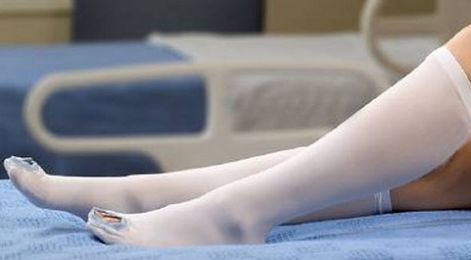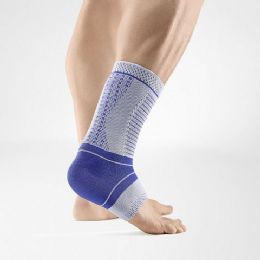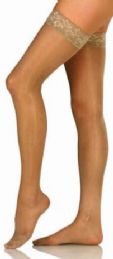








~8.jpg&newheight=260&quality=80)
~7.jpg&newheight=260&quality=80)

What are Compression Stockings?
Compression stockings are used as an initial treatment for varicose veins. Varicose veins are blood vessels that have become twisted and enlarged. Compression stockings improve blood circulation in the legs by squeezing them, with the tightest area around the ankles and the pressure decreasing as the stocking goes up the leg. These stockings look a lot like pantyhose, and thigh high or knee high stockings, and are often applied as a non-surgical varicose vein treatment as well as for post-surgical support.
Varicose veins typically look like bulging blue or purple lines that twist and wind along the legs. In healthy veins, the valves make the blood flow in one direction and they block the blood from back flowing. The valves in varicose veins do not close completely, which causes the blood to pool and the veins to become enlarged. Spider veins are similar to varicose veins, but appear much smaller. They also may be present in the face as well as the legs.
Along with their appearance, symptoms of this condition include muscle cramping, aching, a burning sensation in the legs, itching around the veins, swelling in the lower legs, and discomfort after sitting or standing for long periods of time. Skin ulcers may form around the ankles in some cases. The likelihood of developing varicose veins increases with advancing age, pregnancy, family history of varicose veins, obesity, being female, and standing for long periods of time. Compression stockings can diminish the symptoms of this condition, but they do not cure it.
Since the stockings apply more pressure around the ankles and less towards the top of the legs, they encourage the blood to move up the legs towards the heart. This aids in preventing blood from accumulating in the feet and lower legs. The pressure reduces discomfort, swelling/edema, and the chances of forming a blood clot. A blood clot happens when the clotting agents in the blood cause elements of the blood to stick together, or coagulate. In a healthy body this is an important mechanism, but unneeded clots formed by stagnant blood can cause serious health issues. These issues may be stroke, pulmonary embolism, or death of the tissue.
Compression stockings are available in many styles and colors, and are made of an elastic material. For best results, they should be worn every day, all day long, and taken off at night. Since the stockings are tight, they may need to be tugged fairly hard to pull them over the feet and ankles. This may pose a problem for those with arthritis or other conditions that cause weakness in the hands, but there are stocking donners available that can provide assistance.
What is Pedal Edema?
Pedal edema refers to swelling in the body’s legs and feet. The direct cause of edema is the accumulation of fluid within the tissue of the affected body parts, and there are many underlying causes that can produce it. Old age is one of the most common causes of pedal edema. Aging is also connected with several other specific causes. These include varicose veins and other issues with circulation in the legs and feet. Rheumatoid arthritis can cause edema through inflammation, and sitting or standing without moving around for long periods of time can also be enough to cause this condition.
Other potential causes include clots, infections, lymphatic obstructions, burns, bites, or stings. Swelling can result from any change to the pressure of tissue or fluid in the legs, including blood vessel pressure, inflammation, lymphatic pressure, and other changes. All of these factors go together with the effects of gravity, which is why the feet and legs are the most common targets of edema.
Hormones associated with menstruation and pregnancy can induce edema in some women. There are drugs that can cause this condition as well, in particular, steroids and blood pressure medication. Some types of antidepressants can also be the cause of pedal edema. Pedal edema is a common side effect of other more serious medical conditions, too. Emphysema reduces the ability of the body to get oxygen through the lungs, therefore, swelling of the feet and legs can occur. Problems with the heart, kidney, liver, and bladder can have similar effects. Altitude sickness, which is caused by extreme changes in pressure, can cause pedal and other forms of edema.
How are Diabetes and Swollen Feet Connected?
Many physical disorders may cause a connection between swollen feet and diabetes. For diabetics, one of the most common underlying issues is neuropathy, a degenerative disease that affects the nervous system. The damaged nerves cannot send pain and discomfort signals to the brain, therefore, diabetics often suffer from foot infections and injuries. In neuropathy, the blood vessels do not constrict and relax normally, triggering a fluid buildup.
Another very serious disorder is nephropathy. This is a disease of the kidneys which also causes swollen feet and ankles. Charcot’s arthropathy is a complication of neuropathy that can show itself in those with diabetes, and a typical symptom is swollen feet. It may occur in both feet, but it generally affects only one foot. The symptoms are usually lack of pain, sudden swelling, and slow healing foot injuries. Those with Charcot’s frequently report the affected foot is warm to the touch.
In addition, peripheral vascular disease can make feet swell in diabetics. Often, diabetics experience some swelling in the feet when beginning an insulin treatment. However, this swelling usually disappears in a few weeks. When experiencing excessive swelling in the feet, ankles, or legs, an individual should consult a doctor. Although there is a strong connection between swollen feet and diabetes, many other factors may be the actual cause. Those with liver dysfunction or high cholesterol buildup in the blood vessels may also exhibit swelling in the lower extremities.
Hulet Smith, OT
Rehabmart Co-Founder & CEO
lb